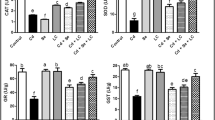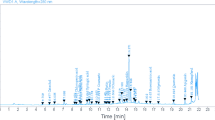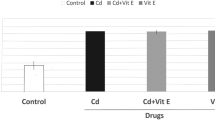Abstract
The protective effects of melatonin, vitamin E, and selenium alone or in combination were tested against cadmium-induced oxidative damage in rat testes. A total of 60 male rats were equally divided into five study groups, one of which acted as control receiving subcutaneous injections of physiological saline. The remaining four groups were treated with subcutaneous injections of cadmium chloride at a dose of 1 mg/kg weight. The first study group received no treatment. The second group was treated with a combination of 60 mg/kg vitamin E and 1 mg/kg sodium selenite. Group 3 was treated with 10 mg/kg melatonin, and the fourth group received a combination of vitamin E, sodium selenite, and melatonin at the doses mentioned above. After 1 month, the animals were killed, and the testes were excised for histological inspection and determination of tissue malondialdehyde and the activity of superoxide dismutase. The animals receiving no treatment showed significantly higher malondialdehyde levels and reduced activity of the enzyme (p < 0.05). Treatment with antioxidants resulted in a significant reduction in malondialdehyde when compared to the nontreated animals (p < 0.05) and an increase in the superoxide dismutase activity that was almost the same as the controls. The combination of melatonin, vitamin E, and selenium appears to have the more profound effect against cadmium-induced testicular injury.



Similar content being viewed by others
References
Robarts K, Worsfold P (1991) Cadmium: toxicology and analysis, a review. Analyst 116:549–568
Santos FW, Oro T, João GZ, Rocha BT, Nascimento PC, Nogueira CW (2004) Cadmium induced testicular damage and its response to administration of succimer and diphenyl diselenide in mice. Toxicol Lett 152:255–263
Shaikh ZA, Tang W (1999) Protection against chronic cadmium toxicity by glycine. Toxicology 132(2–3):139–146
Muller L (1986) Concequences of cadmium toxicity in rat hepatocytes. Mitochondrial dysfunction and lipid peroxidation. Toxicology 40:285–295
Liu J, Liu Y, Michalska AE, Andy Choo KH, Klaassen CD (1996) Distribution and retention of cadmium in metallothionein I and II null mice. Toxicol Appl Pharmacol 136:260–268
Andersen HR, Andersen O (1988) Effect of cadmium chloride on hepatic lipid peroxidation in mice. Pharmacol Toxicol 63(3):173–177
Sarkar S, Yadav P, Trivedi R, Bansal AK, Bhatnagar D (1995) Cadmium-induced lipid peroxidation and the status of the antioxidant system in rat tissues. J Trace Elem Med Biol 9(3):144–1499
Stohs SJ, Bagchi D, Hassoun E, Bagchi M (2001) Oxidative mechanisms in the toxicity of chromium and cadmium ions. J Environ Pathol Toxicol Oncol 20:77–88
Kara H, Karatas F, Canatan H, Servi K (2005) Effects of exogenous metallothionein on acute cadmium toxicity in rats. Biol Trace Elem Res 104(3):223–232
Alvarez SM, Gomez NN, Scardapane L, Zirulnik F, Martinez D, Gimenez MS (2004) Morphological changes and oxidative stress in rat prostate exposed to a non-carcinogenic dose of cadmium. Toxicol Lett 153:365–376
Tandon SK, Singh S, Prasad S, Khandekar K, Dwivedi VK, Chatterjee M, Mathur N (2003) Reversal of cadmium induced oxidative stress by chelating agent, antioxidant or their combination in rat. Toxicol Lett 145:211–217
Manca D, Ricard AC, Trottier B, Chevalier G (1991) Studies on lipid peroxidation in rat tissues following administration of low and moderate doses of cadmium chloride. Toxicology 67:303–323
El-Demerdash FM, Yousef MI, Kedwany FS, Baghdadi HH (2004) Cadmium-induced changes in lipid peroxidation, blood hematology, biochemical parameters and semen quality of male rats: protective role of vitamin E and β-carotene. Food Chem Toxicol 42:1563–1571
Bagchi D, Bagchi M, Hassoun E, Stohs SJ (1996) Cadmium-induced excretion of urinary lipid metabolites, DNA damage, glutathione depletion and hepatic lipid peroxidation in Sprague–Dawley rats. Biol Trace Elem Res 52:143–154
Xu LC, Sun H, Wang S, Song L, Chang HC, Wang XR (2005) The roles of metallothionein on cadmium-induced testes damages in Sprague–Dawley rats. Environ Toxicol Pharmacol 20:83–87
Stajn A, Zikic R, Ognjanovic VB, Saicic ZS, Pavlovic SZ, Kostic MM, Petrovic VM (1997) Effect of cadmium and selenium on the antioxidant defense system in rat kidneys. Comp Biochem Physiol 117C:167–172
Jurczuk M, Brzoska MM, Moniuszko-Jakoniuk J, Galazyn-Sidorczuk M, Kulikowska-Karpinska E (2004) Antioxidant enzymes activity and lipid peroxidation in liver and kidney of rats exposed to cadmium and ethanol. Food Chem Toxicol 42:429–438
Karatas F, Karatepe M, Baysar A (2002) Determination of free malondialdehyde in human serum by high-performance liquid chromatography. Anal Biochem 311:76–79
Sun Y, Oberley LW, Li Y (1988) A simple method for clinical assay of superoxide dismutase. Clin Chem 34:497–500
Luna G (1968) Manual of histologic staining method of armed forces. Institute of Pathology. McGraw-Hill, New York, pp 222–226
El-Maraghy SA, Gad MZ, Fahim AT, Hamdy MA (2001) Effect of cadmium and aluminum intake on the antioxidant status and lipid peroxidation in rat tissues. J Biochem Mol Toxicol 15(4):207–214
Xiao P, Jia XD, Zhong WJ, Jin XP, Nordberg G (2002) Restorative effects of zinc and selenium on cadmium-induced kidney oxidative damage in rats. Biomed Environ Sci 15:67–74
Hussain T, Shukla GS, Chandra FS (1987) Effects of cadmium on supeoxide dismutase and lipidperoxidation in liver and kidney of growing rats: in vivo and in vitro studies. Pharmacol Toxicol 60:355–358
Gambhir J, Nath R (1992) Effect of cadmium on tissue glutathione and glutathione peroksidase in rats. Influence of selenium supplementation. Indian J Exp Biol 30:597–601
Blanco A, Moyano R, Vivo J, Flores-Acuna R, Molina A, Blanco C, Aguera E, Monterde JG (2007) Quantitative changes in the testicular structure in mice exposed to low doses of cadmium. Environ Toxicol Pharmacol 23:96–101
Patra RC, Swarup D, Senapati SK (1999) Effects of cadmium on lipid peroxides and superoxide dismutase in hepatic, renal and testicular tissue of rats. Vet Hum Toxicol 41:65–67
Rana SVS, Verma S (1996) Protective effects of GSH, vitamin E and selenium on lipid peroxidation in cadmium-fed rats. Biol Trace Elem Res 51:161–168
Tsia PL, Hu MK (2003) Free radical scavenging and antioxidative activity of melatonin derivatives. J Pharm Pharmacol 55:1655–1660
Tan DX, Reiter RJ, Manchester LC, Yan MT, El-Sawi M, Sainz RM, Mayo JC, Kohen R, Allegra M, Hardeland R (2002) Chemical and physical properties and potential mechanisms: melatonin as a broad spectrum antioxidant and free radical scavenger. Curr Top Med Chem 2:181–197
Kim CY, Lee MJ, Lee SM, Lee WC, Kim JS (1998) Effect of melatonin on cadmium-induced hepatotoxicity in male Sprague–Dawley rats. Tohoku J Exp Med 186:205–213
Noda Y, Mori A, Liburdy R, Packer L (1999) Melatonin and its precursors scavenge nitric oxide. J Pineal Res 27:159–63
Karbownik M, Gitto E, Lewinski A, Reiter RJ (2001) Induction of lipid peroxidation in hamster organs by the carcinogen cadmium: amelioration by melatonin. Cell Biol Toxicol 17:33–40
Gupta RS, Gupta ES, Dhakal BK, Thakur AL, Ahnn J (2004) Vitamin C and vitamin E project rat testes from cadmium-induced reactive oxygen species. Mol Cell 17:132–137
Author information
Authors and Affiliations
Corresponding author
Rights and permissions
About this article
Cite this article
Kara, H., Cevik, A., Konar, V. et al. Protective Effects of Antioxidants Against Cadmium-induced Oxidative Damage in Rat Testes. Biol Trace Elem Res 120, 205–211 (2007). https://doi.org/10.1007/s12011-007-8019-1
Received:
Revised:
Accepted:
Published:
Issue Date:
DOI: https://doi.org/10.1007/s12011-007-8019-1




